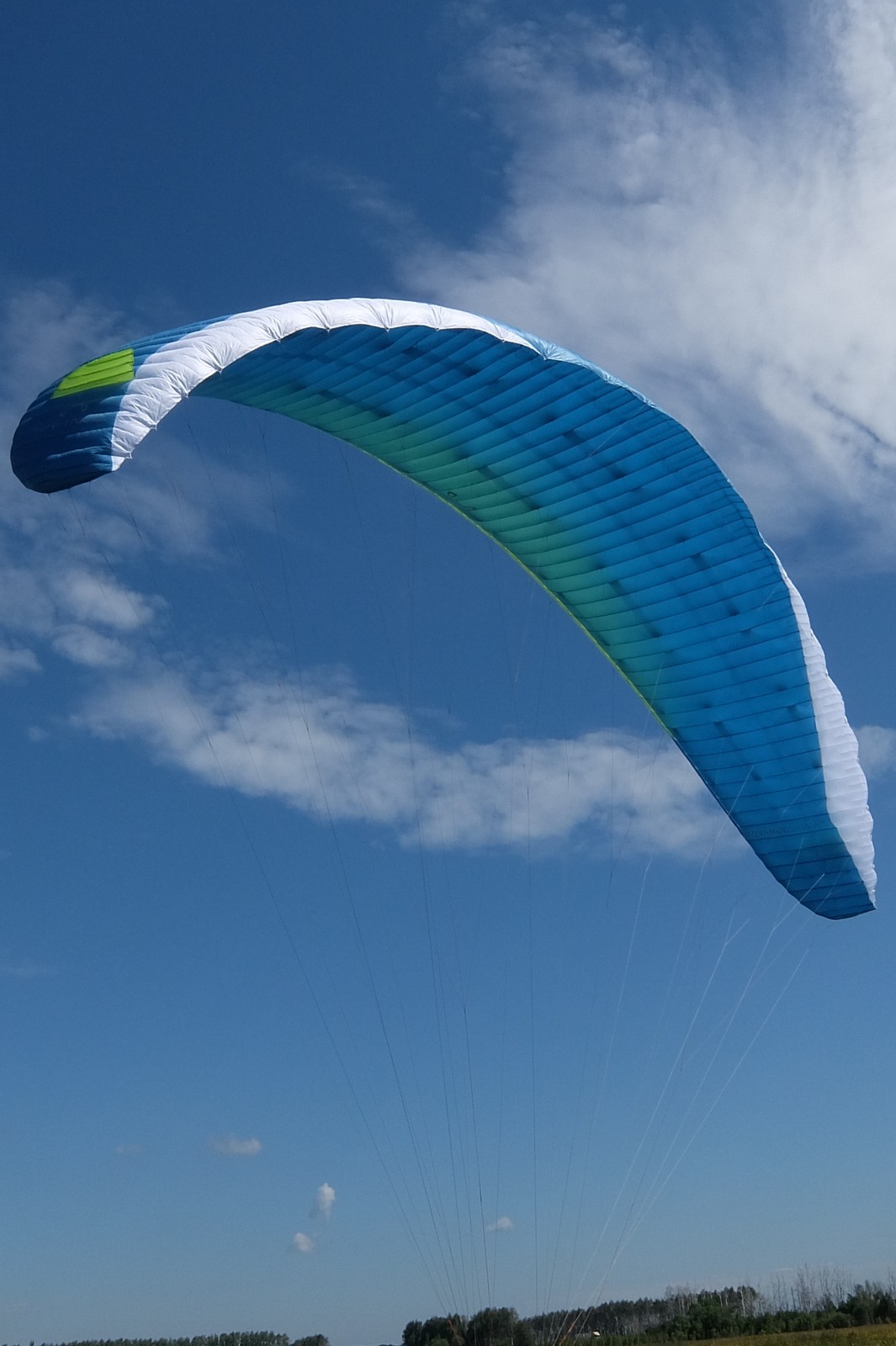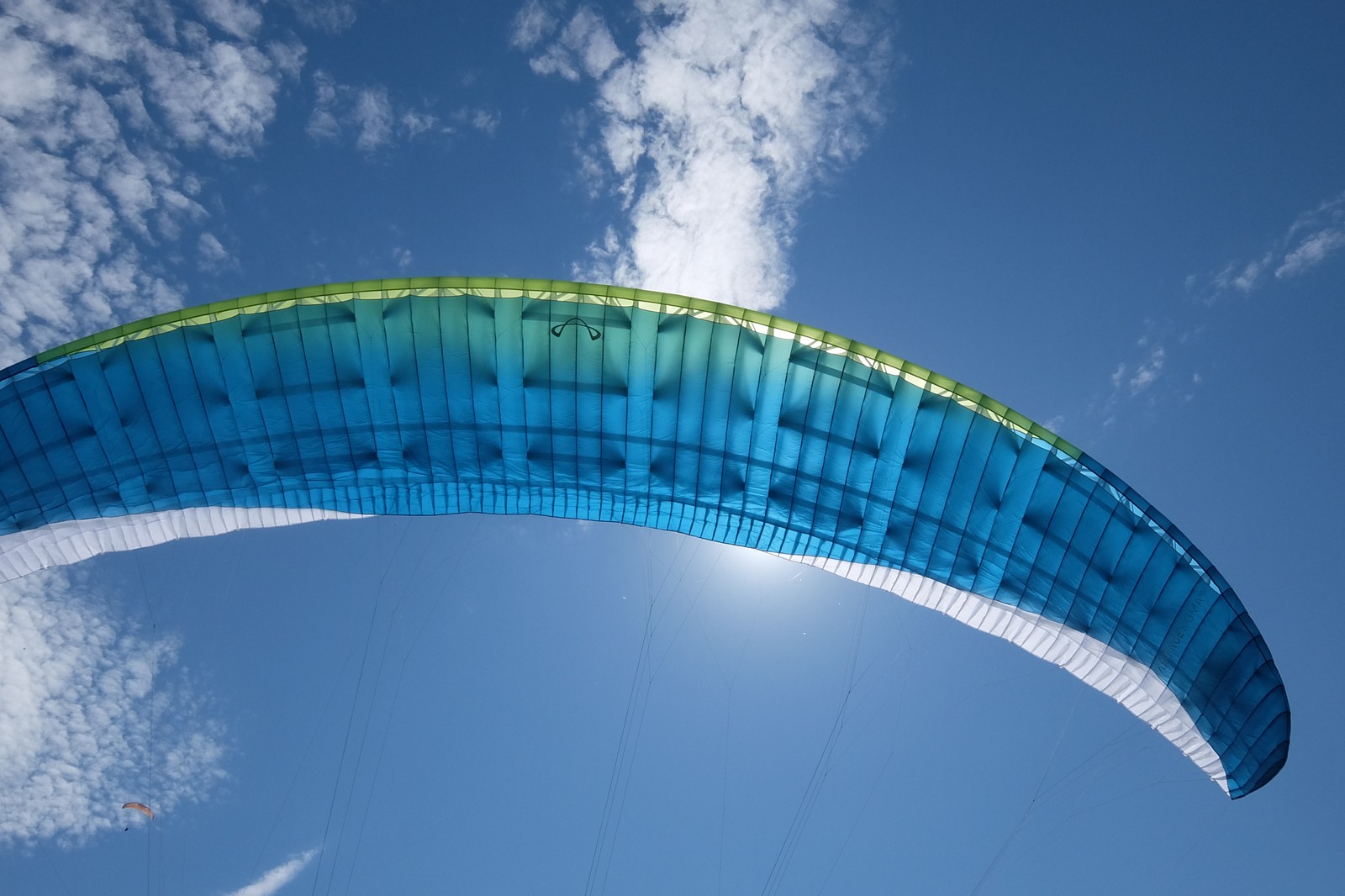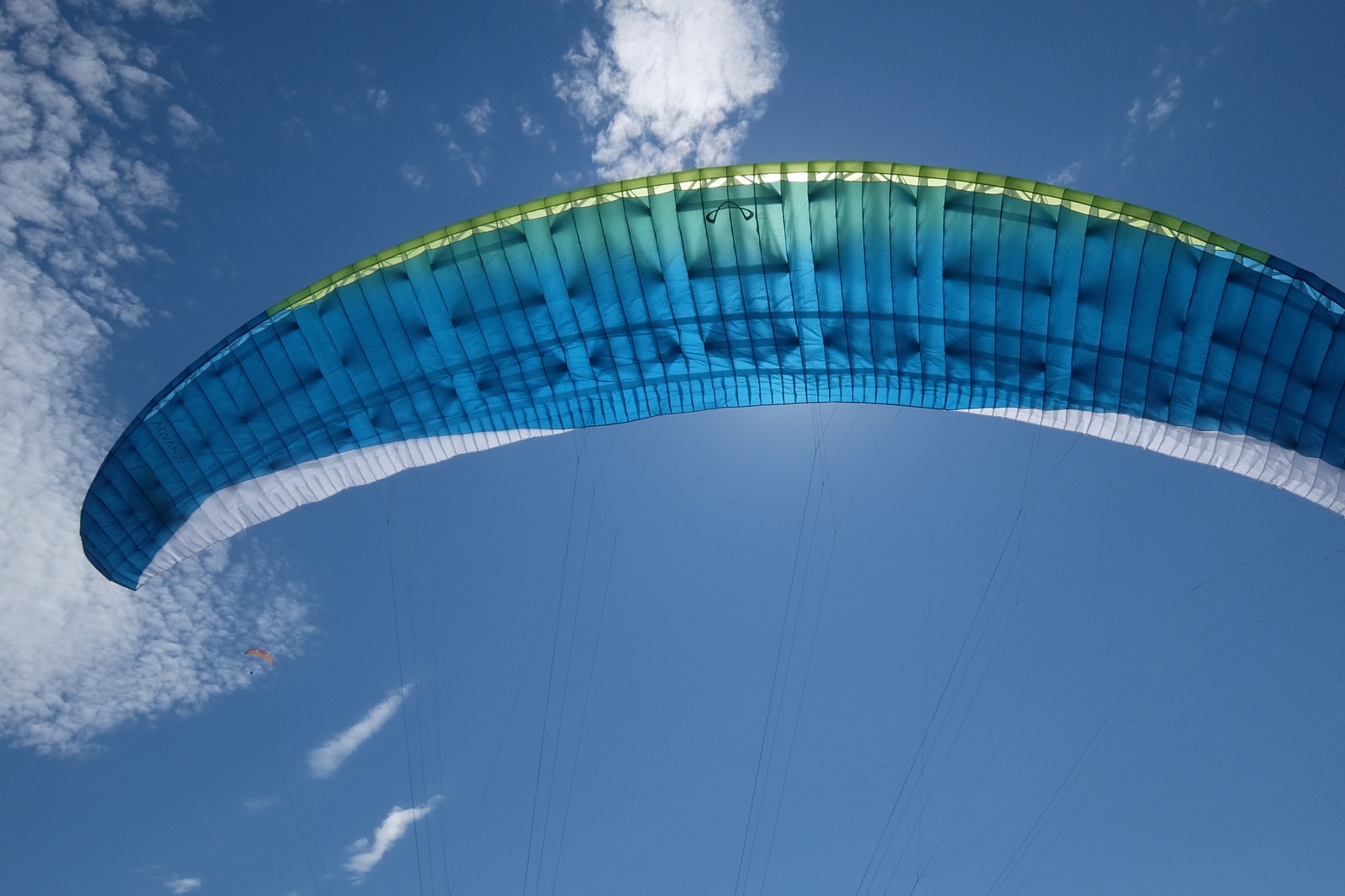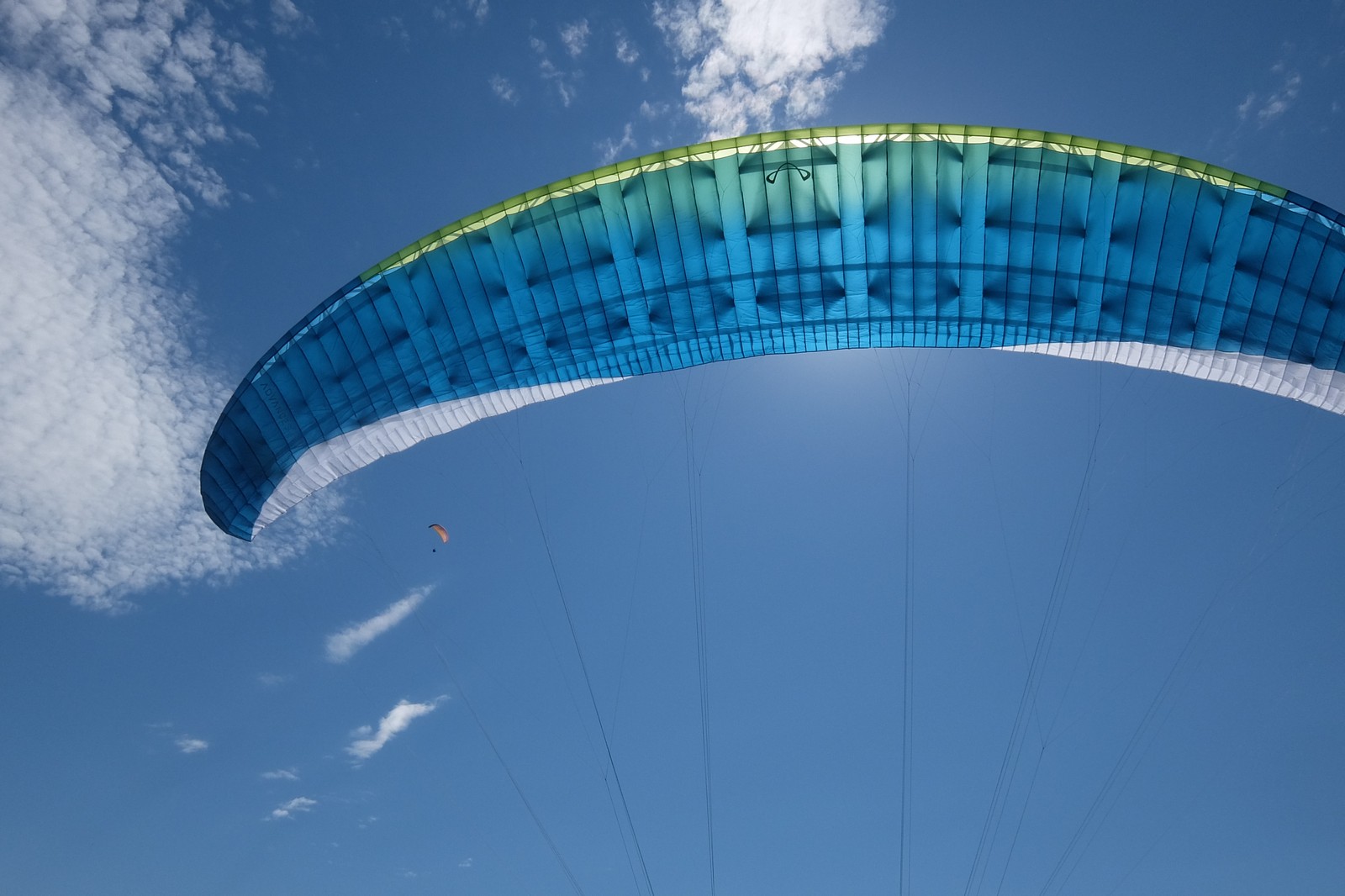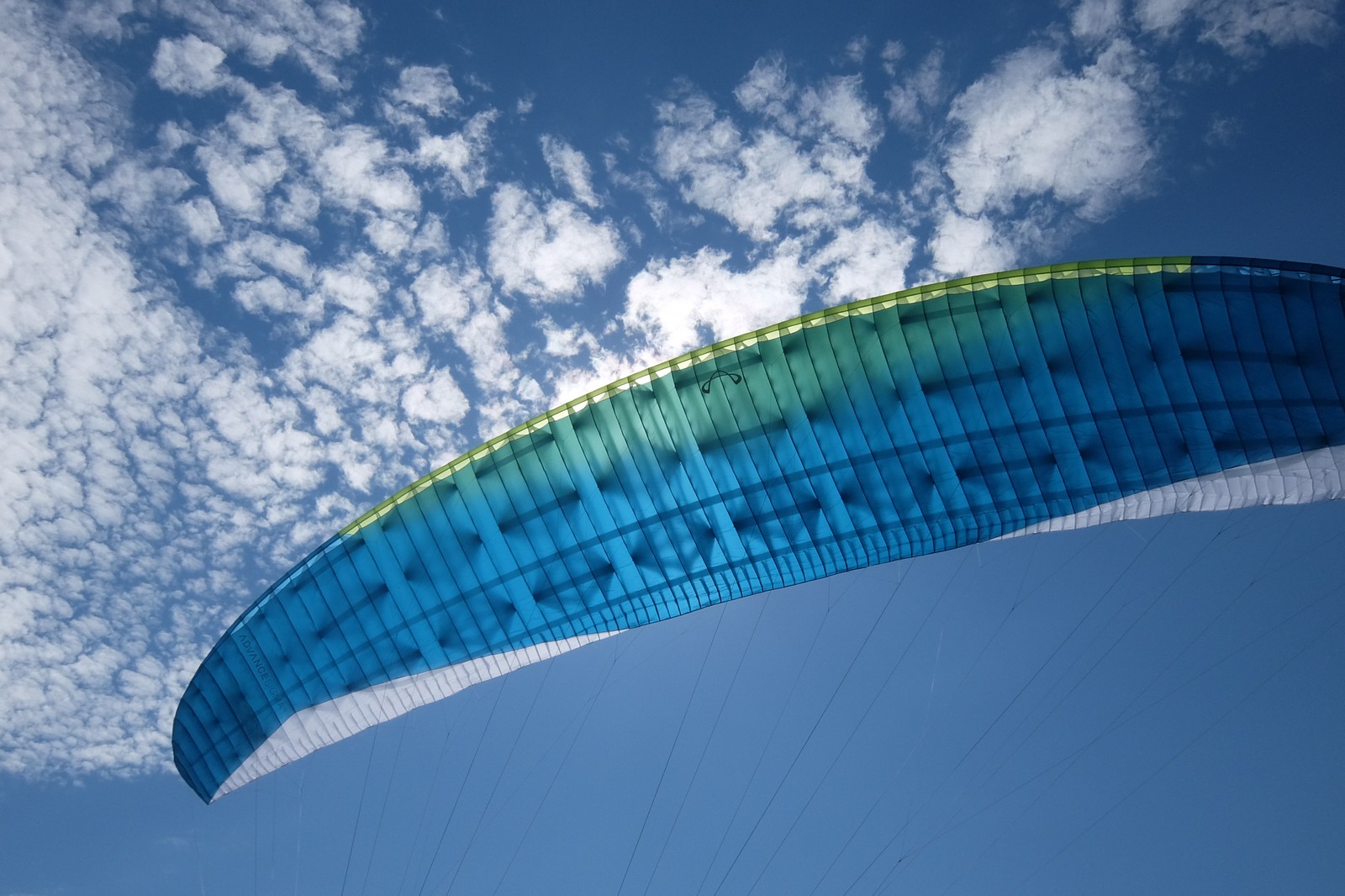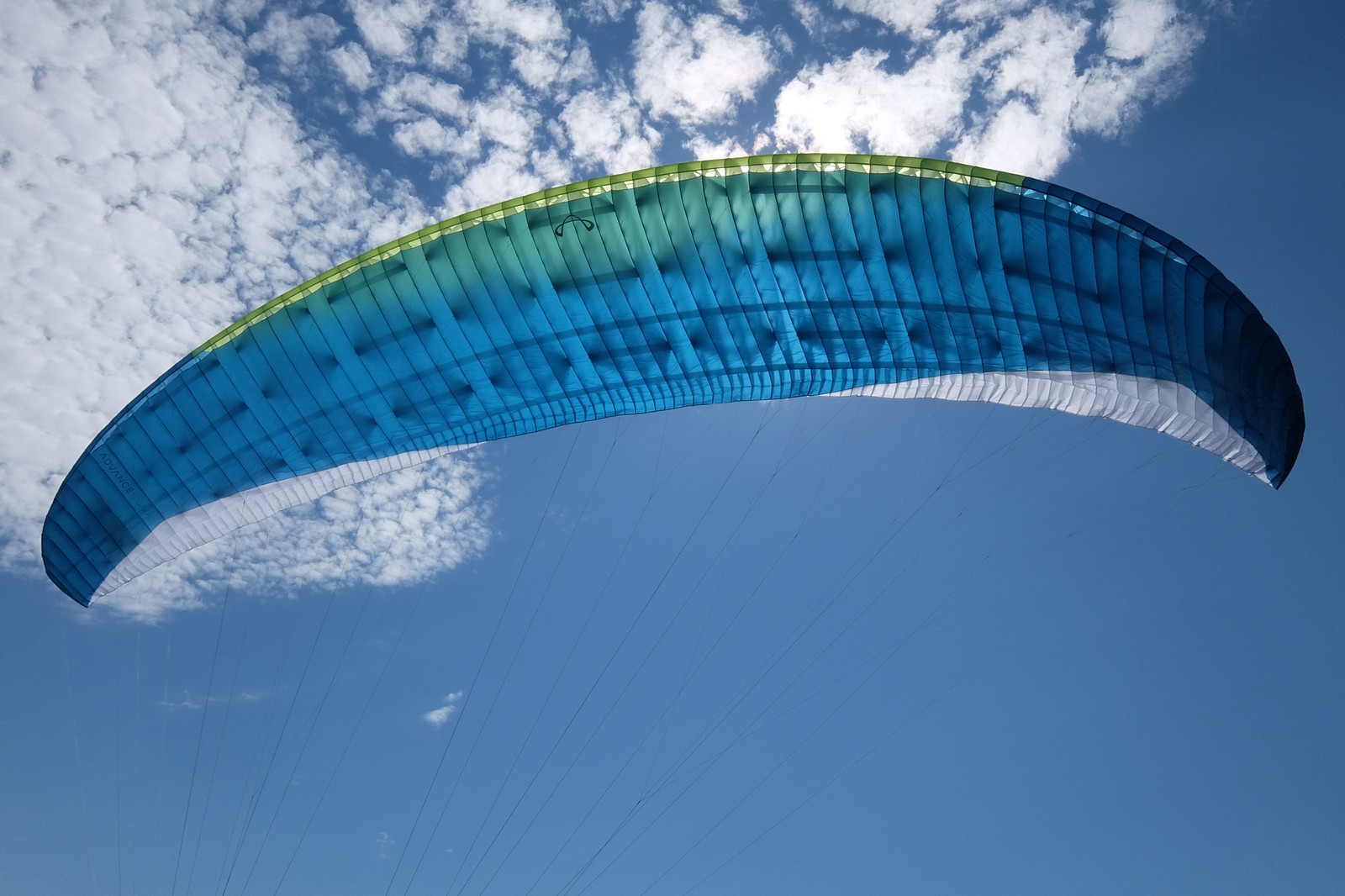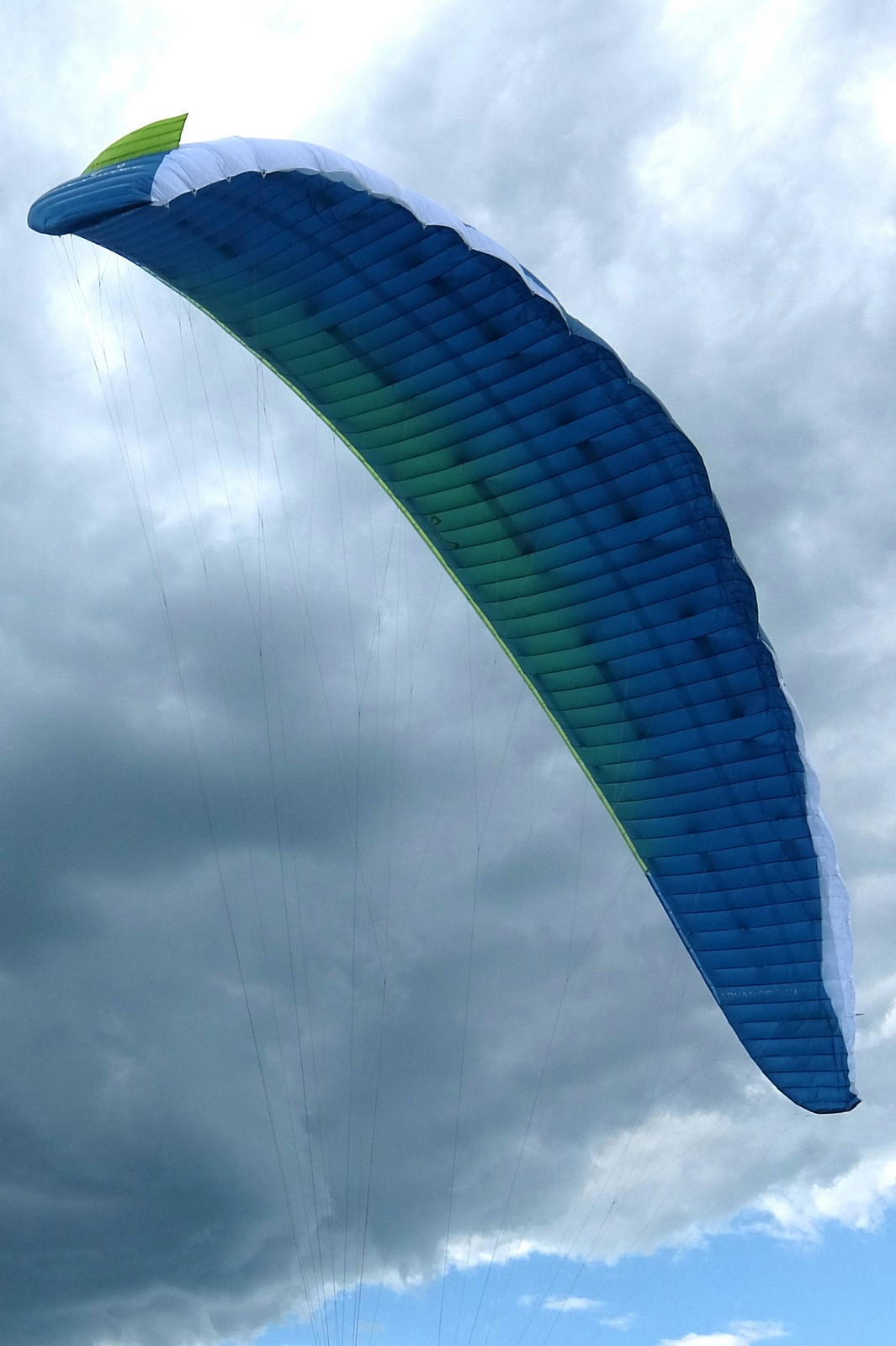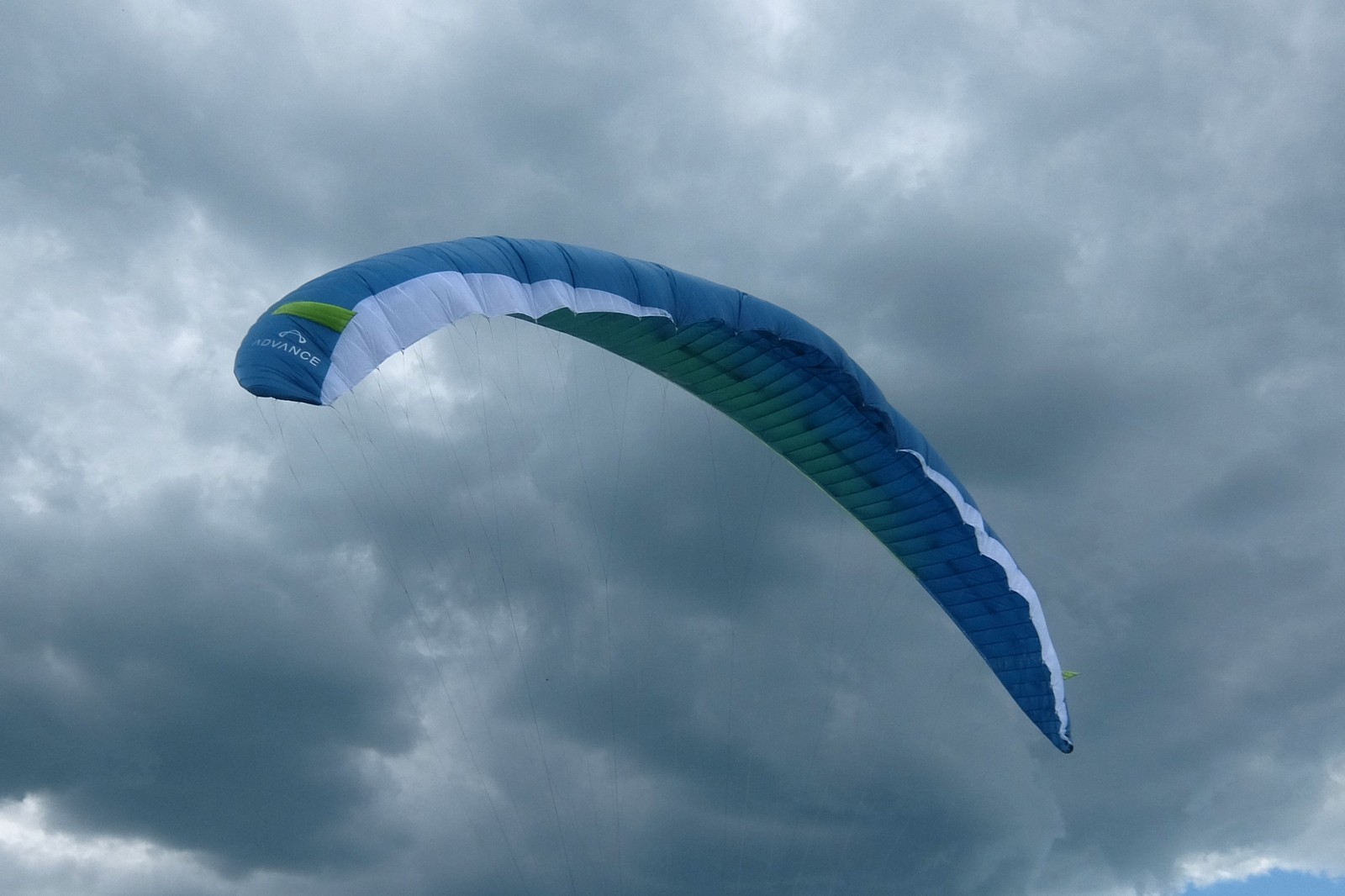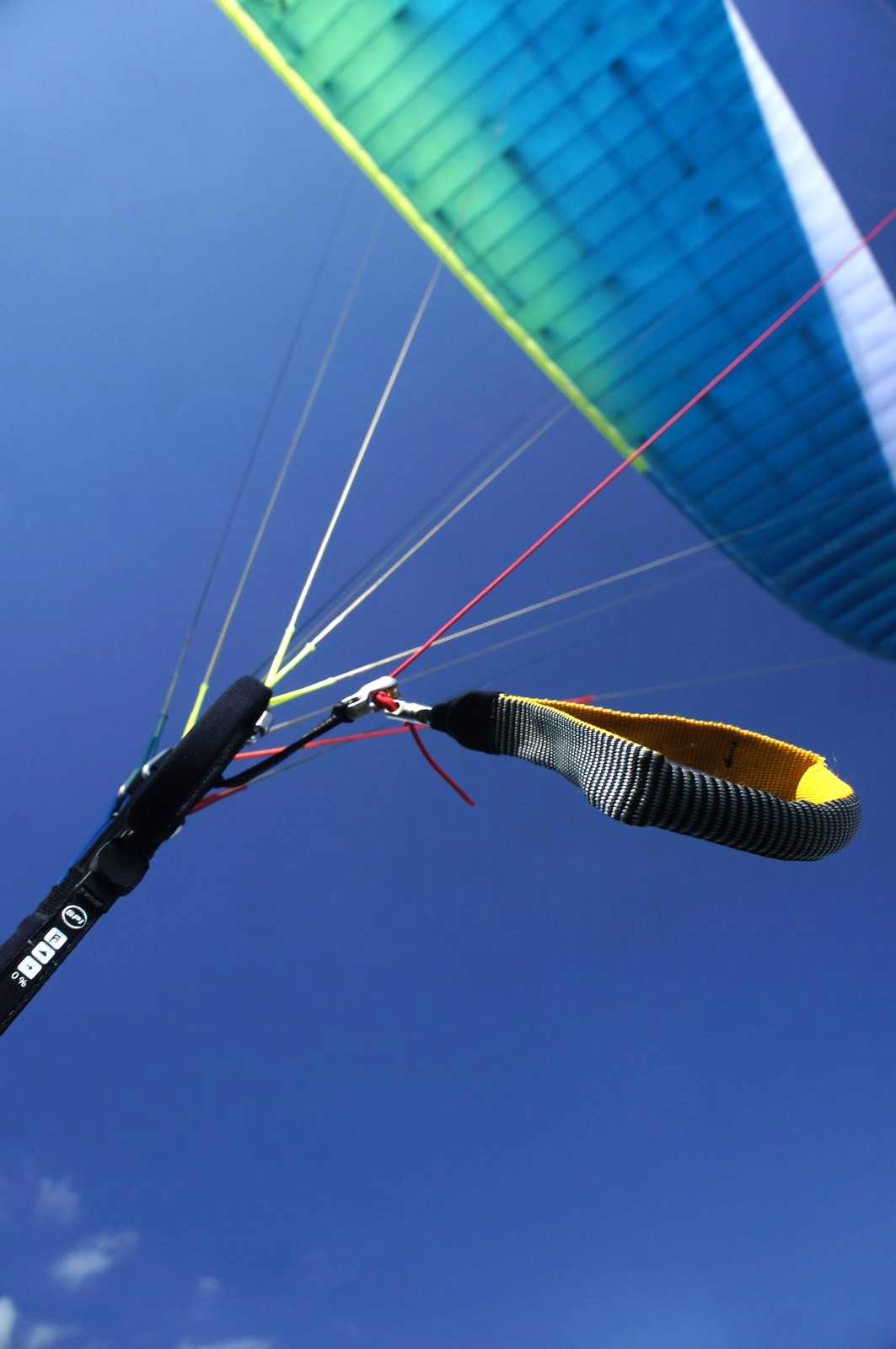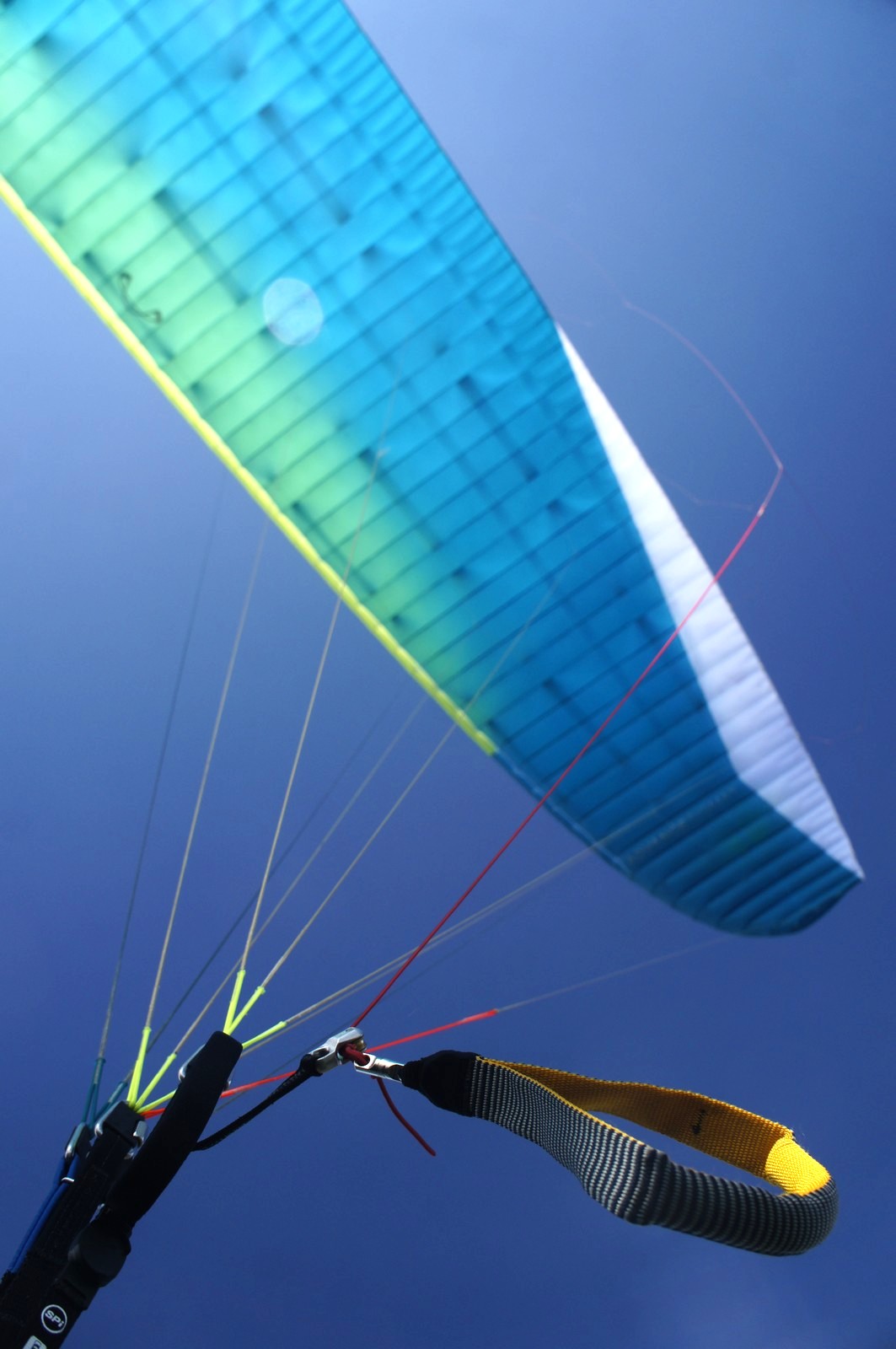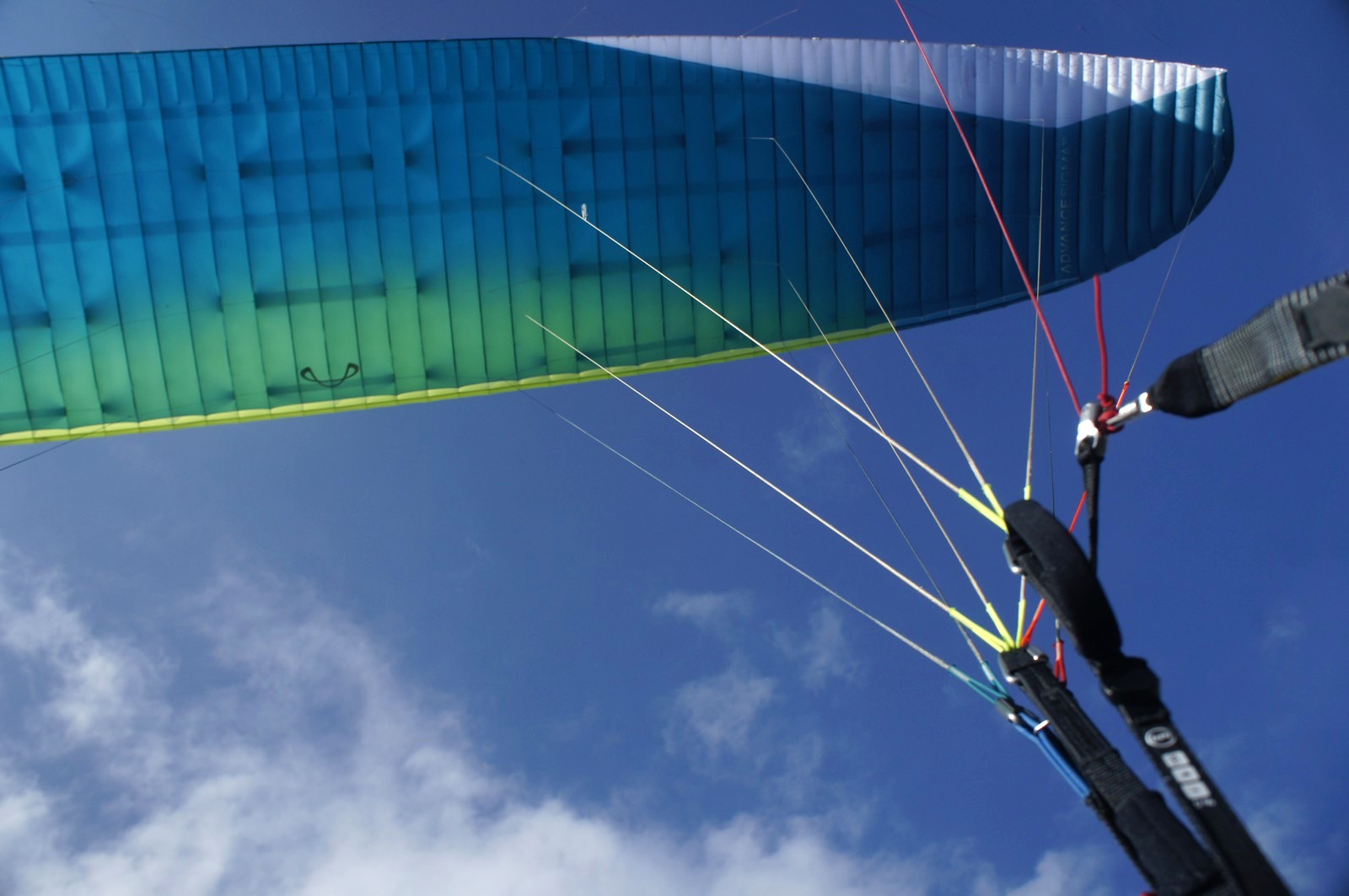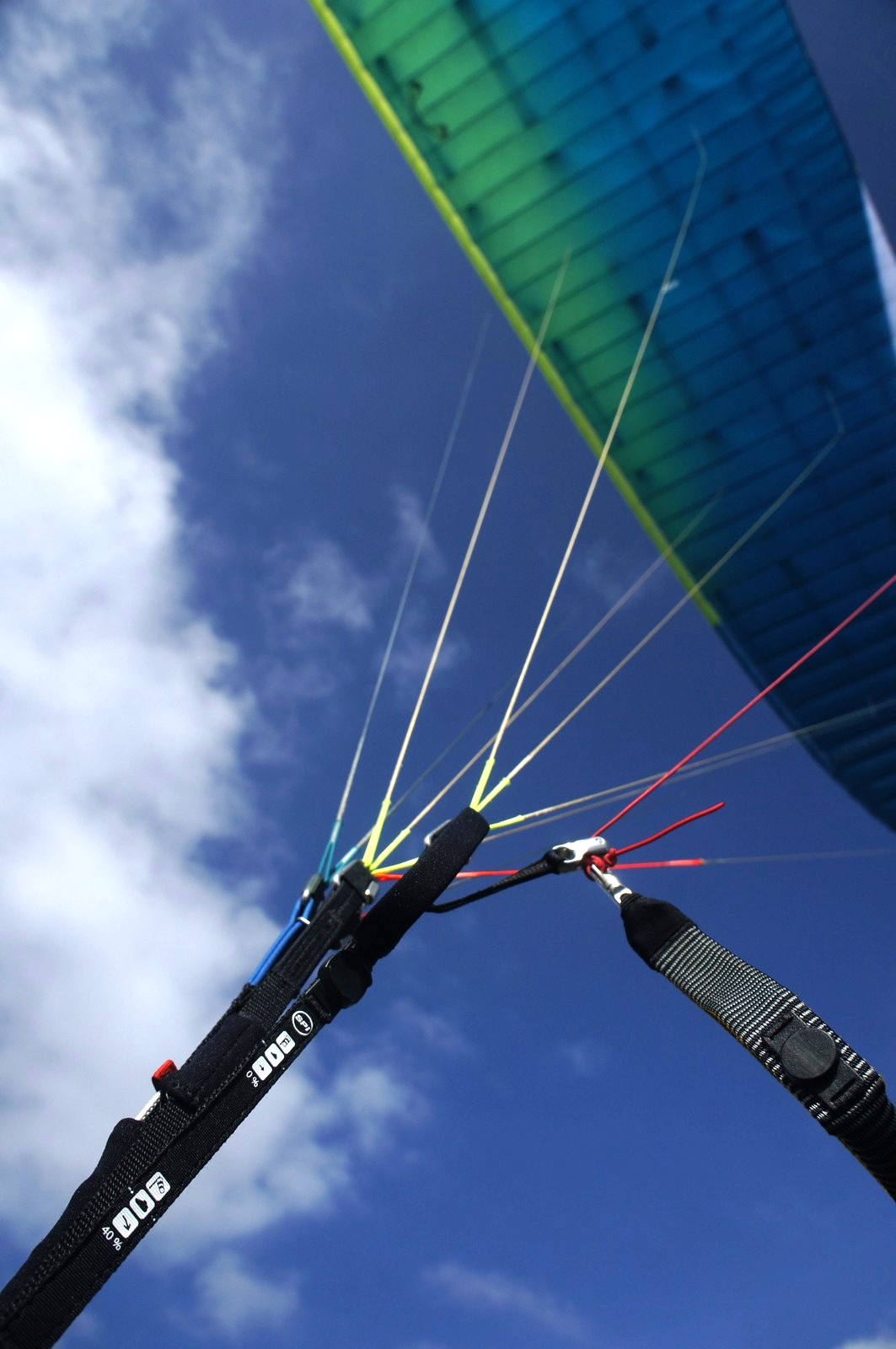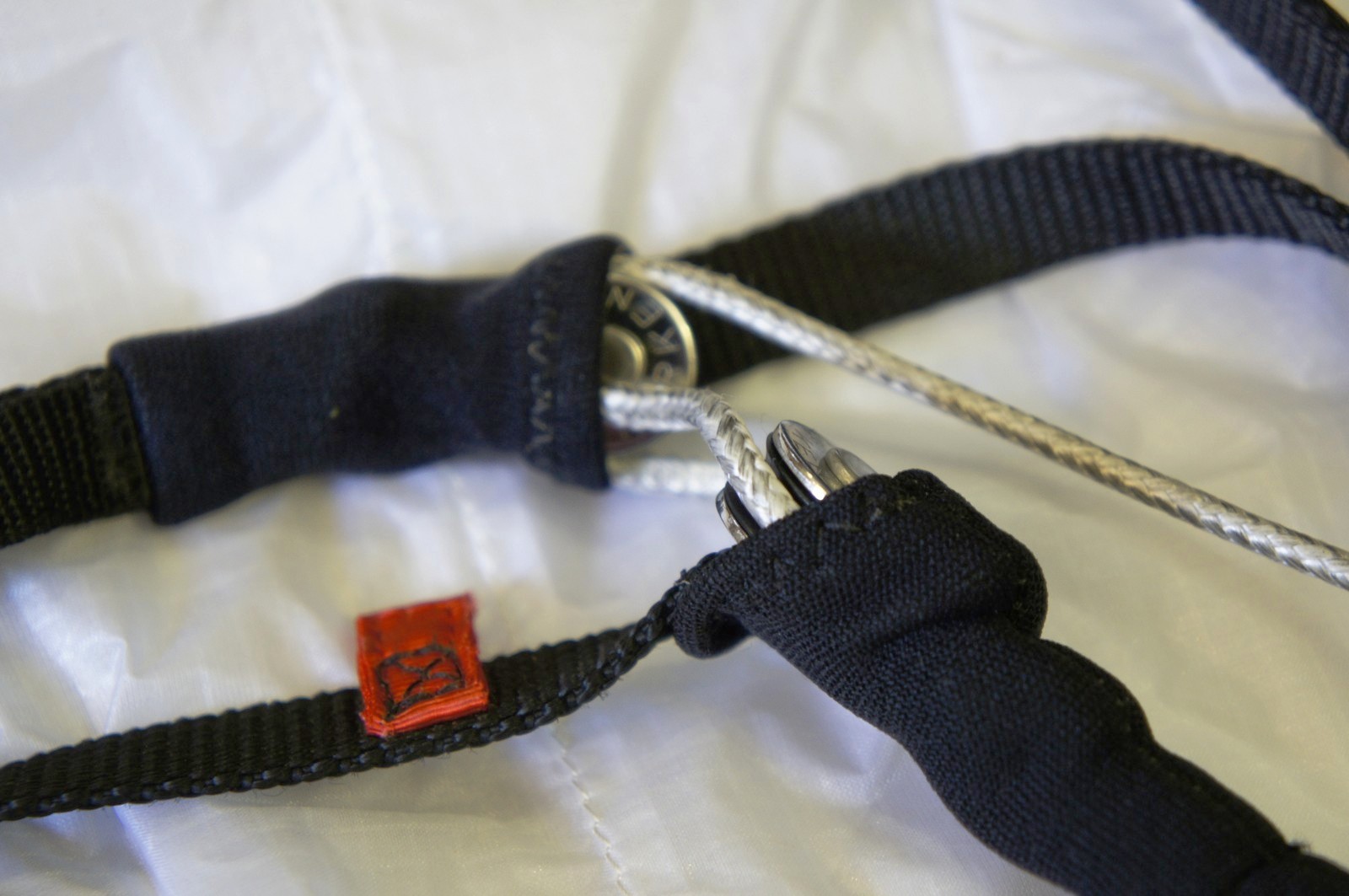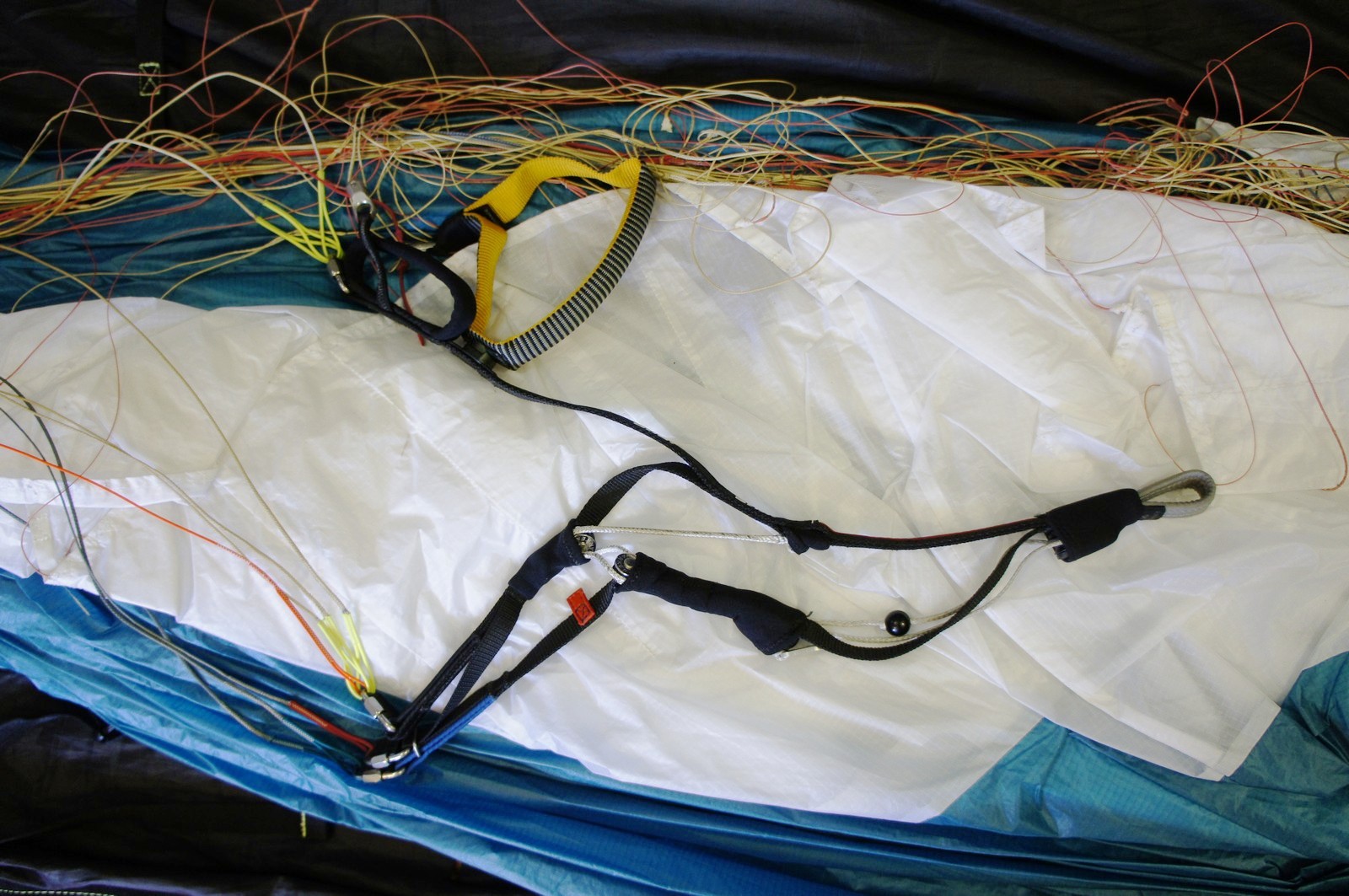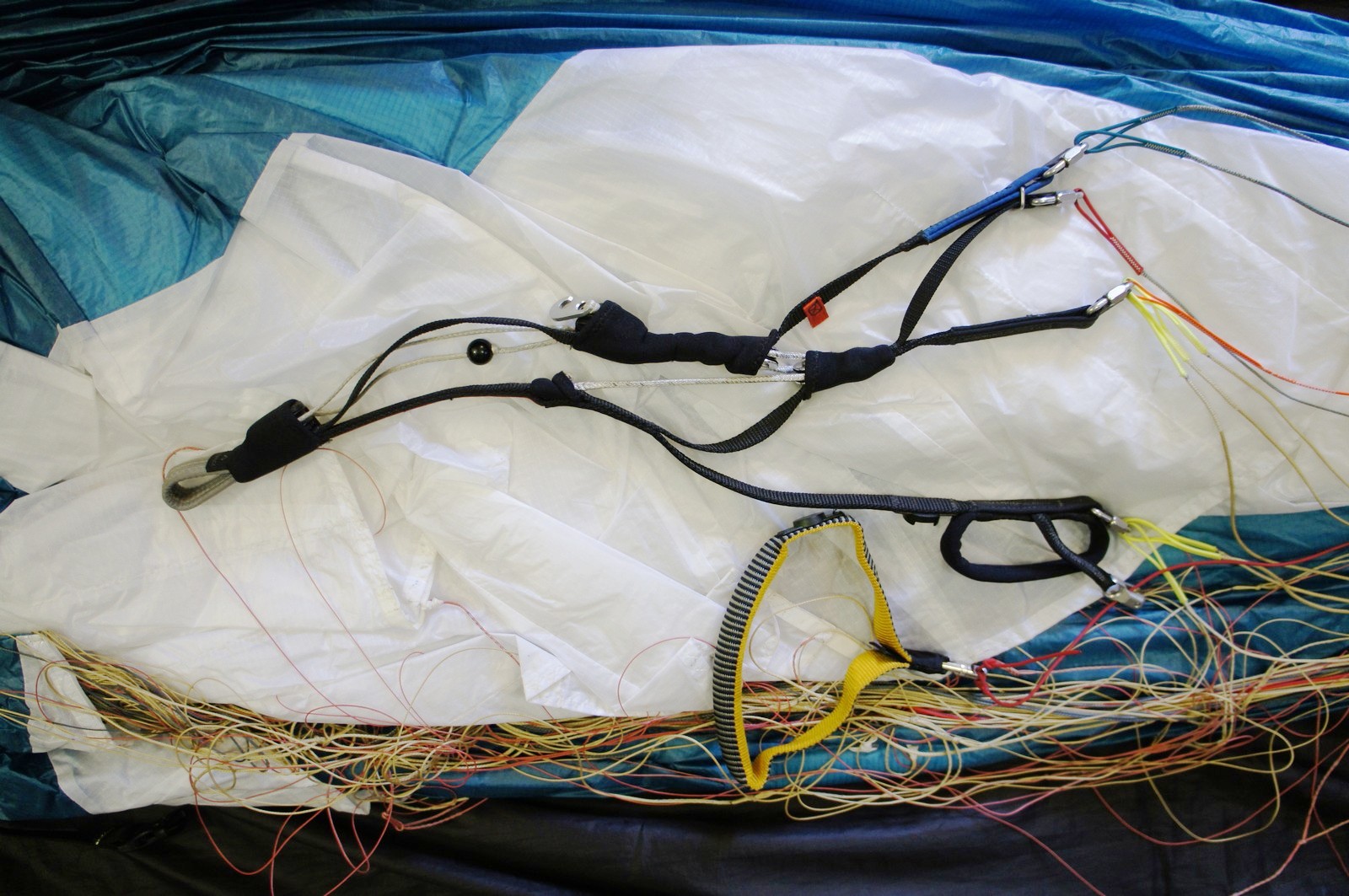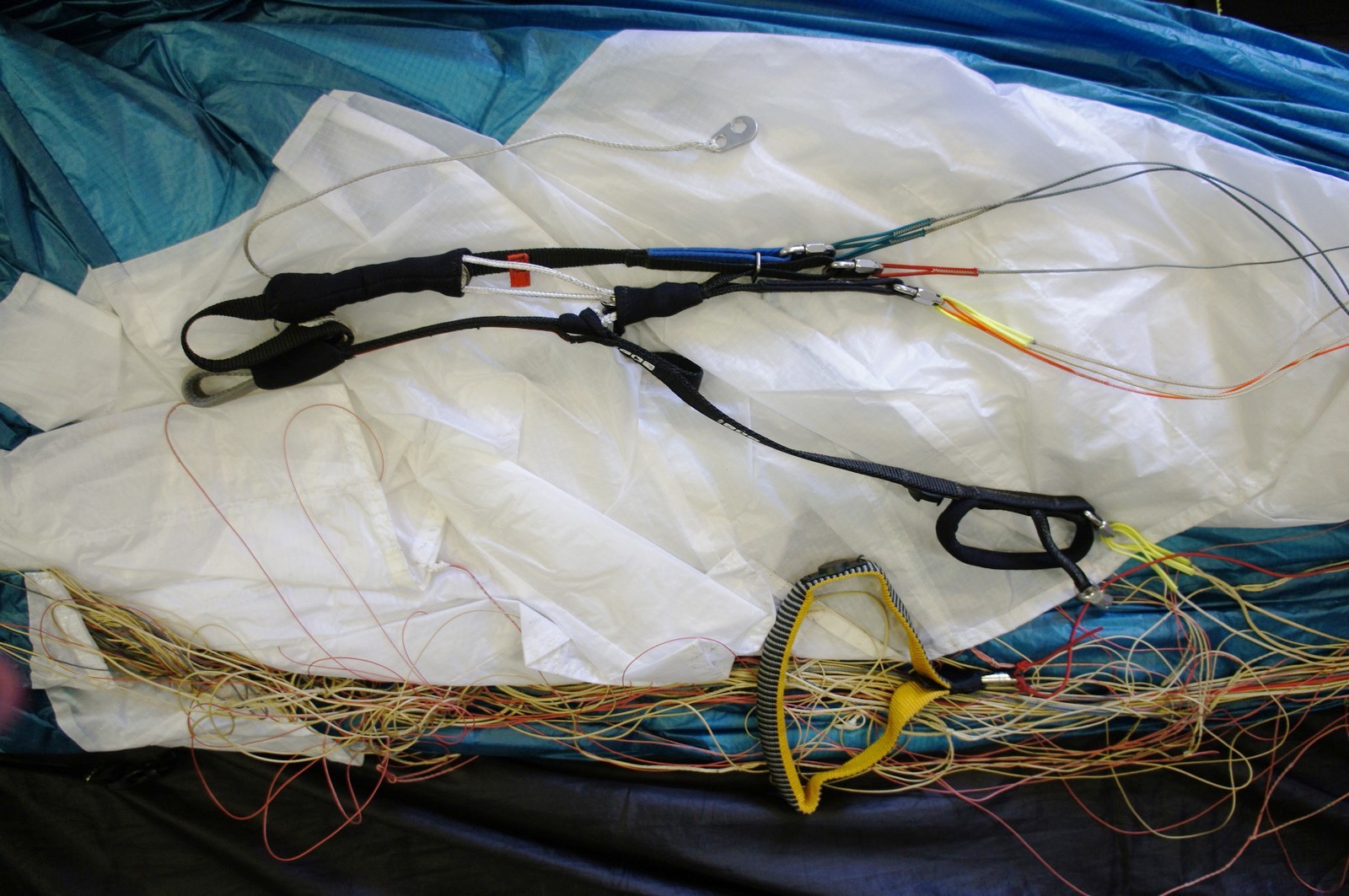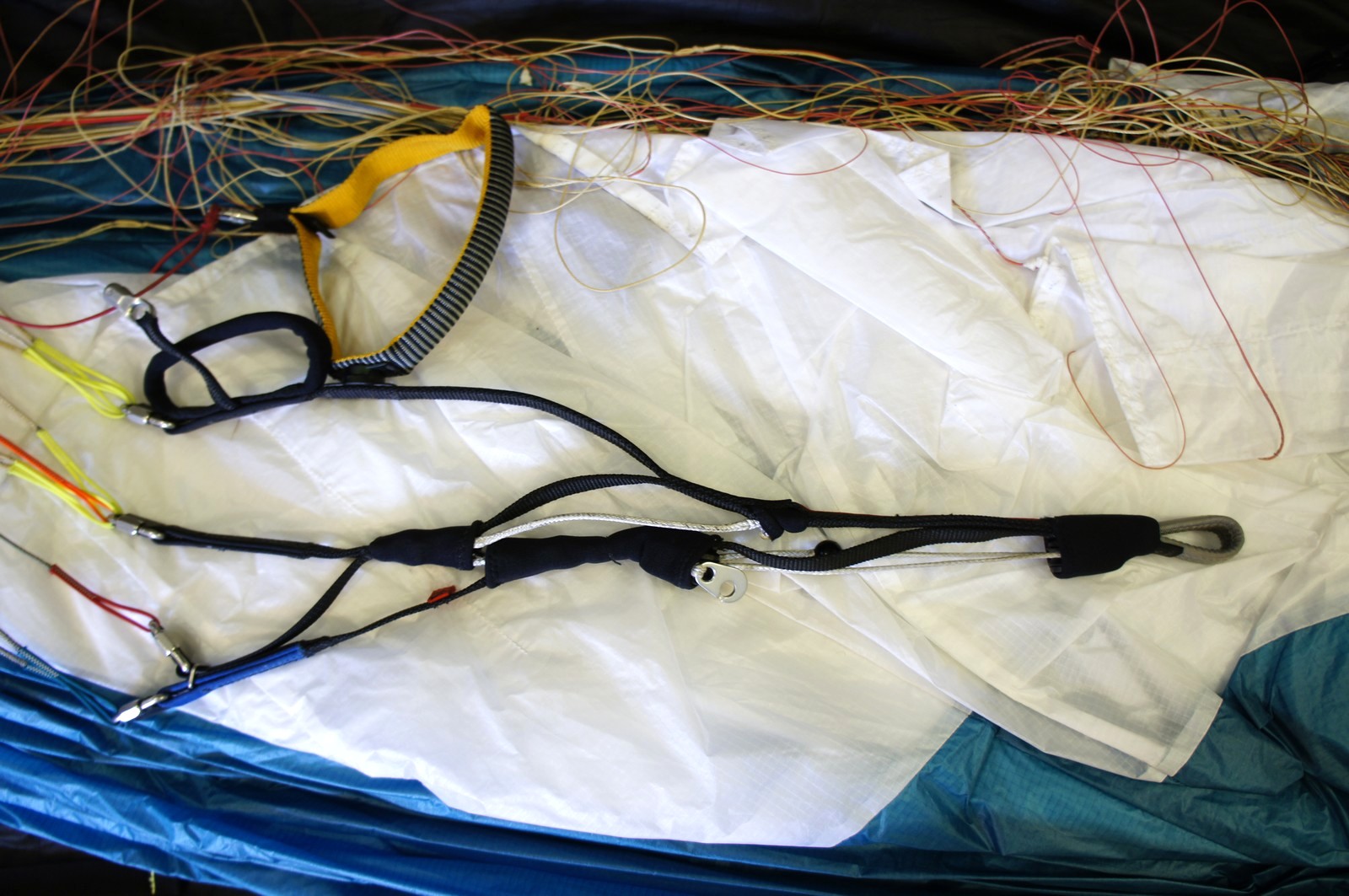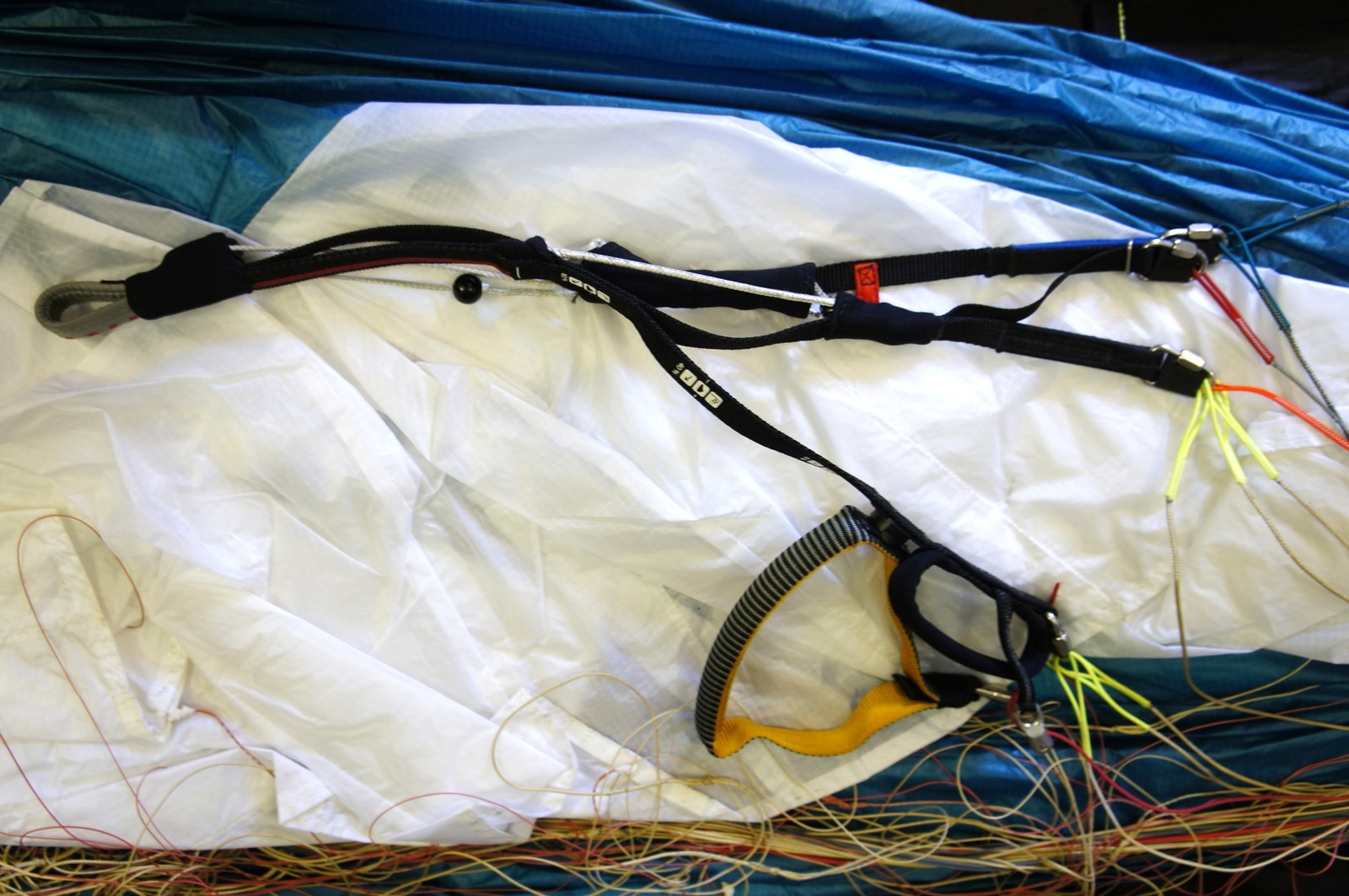Design
I guess I'll have to write an overused phrase "classics and innovations". The classics are in the shape of the wing - a noble one, with a moderate elongation, without unnecessary aggression, in free end design familiar from other Edvans, and in the high quality of craftsmanship. But Edvans did not stint on innovations either! The kinematics of the loose ends are impressive. Lots of blocks, tricky laws of torsion changes, gas pedal with overdrive (a bead that switches off one of the blocks on long strides)... Similar ends - though even a bit more cunning - were used on the 2017 Omega X-Alps. Equally impressive are the thin, strapless slings in protective anti-UV impregnation, starting at the loosest ends. The wing construction, if you look closely, is just as impressive. Very labor-intensive fan braids, lots of ties, big amount of sections for such lengthening, long powerful lines... In general, it seems to be Edvans Edvans, but with very serious ambitions and claims.
Working with the wing on the ground
It's not easy for Edvans to be Edvans in this era of long lines, thin lines and neglecting comfort for the sake of flyability! You have to get out of it somehow. And it is felt even in the process of "grounding". It seems that we are the same Edvans, which 20 years ago was called "paragliding Mercedes", but it is not so. The behavior of the new Sigma is somewhat lacking in the manufacturer's sharpness. It's not that the device straight "shot" in the process of withdrawal, but previous Sigmas were a little easier to pick up - at least in terms of pitch control. Naturally, in terms of sharpness the Sigma is far behind the Delta III and Cayenne V - but by elitist-Edvans standards the tenth incarnation of the Sigma is probably still a bit sharp in pitch. Reaction to work with weight and brakes is quite Evans-like - calm, without excessive sharpness. As a result, you have to move your arms and body a little more vigorously than expected to be at the same wave with your wing and to keep up with its moves. The Sigma, however, is pretty well controlled by the pilot, no problems at all, everything is clear and transparent. Touching the ground with your ear is okay, but there's still a chance of catching a small fold in the ear if you don't have enough control. Lifting technique is expected to be almost irrelevant - no matter what you do with this Sigma, it will end up plus or minus over the pilot's head anyway. You just have to realize that this is a fresh, current Edvans, and control the wing a little more carefully than previous Sigmas.
Towing
Well, it's an Edvans! Tranquility, comfort, that's all it is. The machine is totally predictable under pull, goes off the tow line smoothly and comes back just as smoothly with moderate, no more, weight and pincer work. The peck after unhooking, however, is quite vigorous, although small in amplitude.
Slope start
And again no problems. First try of Sigma on a slope made me do some kiting - slanting wind didn't let me evaporate from the bottom of the slope, I had to put the machine on the grass with my ear, put weight on the top bracket... and ran, ran, ran. As expected, Sigma was very obedient and calm - but the lower "ear" still folded from time to time, which was almost impossible with the previous Edvans in such games.
I managed to test the Sigma also when starting from a steep slope and a strong wind in Chegem. And again no problems. The Sigma surprisingly came out above my head without any real "catching" by the brakes, and in a second we were already in the air.
Flight
It's not easy to say how this new Sigma felt in one word, but I'll try. Transparency! I don't mean the internal structure of the wing through the summer sun, but the particular sensation the Sigma gives to the pilot. There are wings with a bright, complicated character, which makes the pilot get used to the wing, find a common language with it and make not always easy compromises (hello Ozone). But sometimes it is the other way around, you take hold of the wing and from the first minutes of flight you just forget about it, it's so easy and obvious to understand how the wing reacts to the air and to your own movements. This is exactly what the Sigma is all about. Character, simple, clear and transparent to the point of almost complete absence of character, somehow.
Separately, I would like to highlight my impressions of flying the Sigma in Chegem. If you do not know the place is mountainous with narrow, turbulent and strong streams. The best place for discovering the nature of the wing! Naturally, any device behaves differently in Chegem than on plains near Moscow or on Yuz. But communication with the Sigma did not bring any negative emotions in Chegem either.
Maneuverability. Meticulously, lovingly preserved and cherished Edwards classics with some barely noticeable innovations. The innovations are expressed in a barely noticeable increase in sharpness of reactions and the same delicate decrease in delays. Otherwise, it is exactly the same Edvans, which many pilots love so much. Notorious transparency on the verge of lack of character is observed primarily on the turn. You feel like a badass sportsman when you're spinning on something like Ozone's Delta III - a cool, but quickly exhausting feeling for a pilot. The aforementioned Cayenne Five from Skywok makes the pilot clearly control every inch of his movements - which can be a source of strong positive emotions as well as a serious challenge for the not too experienced pilot. And the Sigma... You just execute a turn and that's it. There's virtually no "layer" between making a decision and putting it into action - the Sigma is so obedient and clear in its reactions to the controls. And it's not a matter of some kind of excessive sharpness and rapidity of reactions (which just create all sorts of "super-sporty" feelings, not always needed). The trick is rather in the nature of the transients, which corresponds very closely to what you expect from the wing. There is no need to calculate timings to get the brake to hit exactly 17.385cm at exactly the right moment. There is no sense of struggle with the wing or the elements. There is only the feeling of coping with the elements, smooth and steady, without any abruptness, totally under control of the pilot. Some kind of magic! I want to repeat this magic again and again. Sigma doesn't mind, she obeys all maneuvers, from gentle, with a small roll, spiral to daring wing-overs. Does the Sigma follow the hand? Yes, it does! It's also part of that magical feeling that's so hard to describe in words.
In Chegem the Sigma revealed its character in a slightly different way. Moderate efficiency of the brackets didn't make it impossible to work in the Chegem's thermals, but it was felt quite often. Sometimes - especially in the most difficult thermals - I have caught myself that I was expecting the wing to react more quickly to the brakes. It is interesting that especially in Chegem conditions I have felt the almost total absence of backlash of the brakes. This peculiarity of the wing becomes really useful for us in mountains. Inevitable in the mountains, powerful and sharp movements of the wing were corrected by surprisingly small movements of the hands - and this was not because of any special efficiency of brakes (Sigma's brakes are normal, no more), but exactly because of absence of backlash. What a pleasant sensation! However, the lack of backlash has its flip side in form of some fall in brake travel before stall - but Sigma communicates very clearly with the pilot through changes of load on hands that are fast growing and frankly uncomfortable near stall. Also, the strong flows convincingly revealed Sigma's love of weight work. In heavy, difficult to centered currents it was enough to flip to one side of the harness (which means to face the ground) - and Sigma steadily went upwards comparing to other paragliders which piloted not so aggressively. Working with the brakes, even quite aggressively, did not produce such effects.
Flying. Not too ambitious, but - traditionally for Edvans - on a decent level, somewhere on the level of Gin Carrera. Objectively it was possible to measure only gain of speed on the gas pedal: about 8... 10 km/h on the first stage, about 13... 15 km/h at full throttle. You can't call Sigma slow, but it doesn't set records in its class. I could estimate the aerodynamic quality only subjectively, in parallel flights. Up to the middle of the right polar part it's a convincing parity with the new, not yet released ParAAvis Ray, and the Carrera flies about the same, if not a little worse. At top speed, the Sigma's quality drops a bit less than that of its older competitors. The thermal drop does not seem to increase as the helix intensity increases, so like all modern wings, the Sigma requires it to be in a roll to be really effective (hi Kirill, I hope you heard me!). The speed range is pretty good too, the Sigma brakes well with the brakes and behaves adequately near the stall line.
Comfort and informativeness. Edvans are often and justifiably chosen for their comfort, but the informativeness of the products of this respected company is often questioned. But perhaps not in our case. The compromise of comfort and informativeness, obviously achieved with considerable effort, has turned out to be quite successful for the Sigma Ten. On the one hand, the Sigma remains quite calm, simple and understandable (which everyone traditionally expects from Edvans). On the other hand, there is clearly more information than in previous incarnations of Sigma. As is often the case with calm and comfortable wings, the information value of the Sigma is primarily the change in airspeed, which is smooth and time-delayed, but sufficiently bright and pronounced to find and work confidently in the currents. The situation with pitch and roll is more interesting: the tested Sigma, although it is an Edwans, is still capable of energetic (not to say "sharp") movements, but they occur rarely and have a very small amplitude: a very good result for a modern design wing, which does not assume excellent damping on all axes. Informativity of load on hands and changes of loads on the main carabiners is expectedly moderate: this is Edvans, not Skywok of some kind! The work in the flow on the Sigma is calm, thorough and thoughtful: the device reliably holds the flow, "follows the hand", as it should be for Edvans, but there is no feeling of sportiness, excitement, desire to compete with someone - there are "hotter" devices for that.
And again I would like to make a separate paragraph about Chegem impressions - they are worth it. In real mountain conditions the Sigma is even more comfortable than on the plain. Just like previous successful Sigmas (models with the indexes 4, 6, 8), the new Sigma10 was a workhorse for long and difficult flights. Despite the notorious harshness of some movements, in strong and turbulent conditions the Sigma did very well. Of course it's not a school dumbwaiter that forgives almost any mistakes, but given the adequacy of the pilot, the Sigma copes well with mountain turbulence. Well known to the regulars of Chegem, the "duty" stream above the Pyramid usually reduces even the wings of EN B class, flown by rather experienced pilots, but the Sigma in this stream only once flapped its ear (of course, with a considerable non-passivity of the pilot!). In general, the wing's behavior under such conditions was pleasantly clear and predictable, and all that was needed from the pilot was a sufficiently quick reaction to maintain the normal flight mode.
Dynamics and power capacity. Both are just above average for the 2017 EN C class. These features of the wing are best felt on wingovers, and on these maneuvers the Sigma behaves like... Sigma! Smoothness, controllability, not excess, power, absence of abruptness - yes, this is what you expect from Edvans, and it does not disappoint (there are Cayenne5, Aspen6, Delta3 and other "hotter" cars for those who want oblique loops "from the ground"). Overclocking before landing is fine for Sigma, but it doesn't go further than this "fine". It's normal, it's an Edwans!
Dangerous Flight Modes
Asymmetric folding
Nice, specifical. It is easy to call up, it is more dynamic than in the previous generations of Sigmas. Immediately after folding, it seems to "pause" for a split second without changing its trajectory, giving the pilot the opportunity to reflect on what happened. And then it goes quite vigorous (by Edwansky standards, it's even very vigorous!), oblique roll of 45 degrees and leaving the trajectory at about 90 degrees. Specificity of the new Sigma in an intriguing way sends the observer into the world of Ozons and high racing technology. It is well noticeable that the filling of the folded part of the wing is not quick and in several steps - probably the combination of high mechanical rigidity of the structure, which even in the partially folded form thinly or poorly maintains the internal volume, and clearly insufficient for instant filling of the air intake area. Sigma as if "swallows" air in strictly measured portions, distributing it inside itself and filling it by jerks. The last such jerk is on the "ear" and happens not in the Edwardian way, powerfully and sharply, with a pop. There is nothing terrible or dangerous in it, but it impresses when you are not used to it. Loss of altitude on the mode is 10-15 meters.
Frontal folding
Good, with specificity. Compared to the "asymmetry", it is as if we were testing a different machine At once I remember the legendary Omega 6, which in its class was surprisingly calm, but loved to "stick" in the folding. After "frontalka" Sigma sharply loses speed and flies backwards in amplitude. After this kind of movement you expect a powerful roll and explosive opening, but there is no way around it: suddenly the Sigma smoothly returns to the head position, taking its time to open and even imitating some kind of parachuting. A second or two seconds - and the wing unfolds, even if with a slight reluctance, but smoothly and with a very slight (20 degrees) flip. we have to put "good" for the loss of altitude, which in this mode is quite great and may reach up to 20-25 meters.
Breakaway from the thermal spiral
Good. Caused by long, but not excessive travel of the inside arm, accompanied by a smooth build-up of the load to large (but still comfortable, not "warning") values, but at the moment of the climax the load on the arm does not fall particularly strongly. But at the beginning of the subcrash the Sigma starts to glide very markedly on the undercut cantilever, and it is rather difficult to miss this specific movement of the wing, in my opinion. The escape from the mode when you partially release the inside hand is almost instantaneous, energetic, with a pronounced roll; it takes some work with both weight and brakes to keep the machine in the spiral.
Conclusions
Our world is constantly changing. And that is why there must be something in it that is almost unchangeable, something that we can believe in, with which we can compare the variability of the surrounding reality. In paragliding such "measure of things" is traditionally the Advance paragliders. And updated Sigma10, despite all its technological advancement and compliance with fashionable trends, still manages to be the same Sigma from the same Edvans. Only really mature pilots, who haven't had supersporty super ambitions (for their satisfaction in the EN C class there's the UP Trango X with the Sigma10), can understand and appreciate the advantages of the new Sigma.there's UP Trango X-Race in EN C class), not chasing for ultra-sensitivity and extreme maneuverability (Skywalk Cayenne5 and Ozone Delta3 are for that), not trying to prove something to somebody. The pilot of the Sigma enjoys the flight and the wing, like a 100-year-old cognac, which does not tolerate fuss and is not needed at all in order to quickly and sharply stiffen. The Sigma Ten (as, indeed, almost any Edvans) is first and foremost about comfort, calm and finely tuned wing reactions, which give a very special, special sense of flight. But all this eternal classics, strangely enough, more or less peacefully coexist in Sigma with quite modern design, decent flight characteristics and even some - hardly noticeable! - harshness in its behavior, appropriate and even inevitable in a decently flying modern wing with the EN C label. The Sigma 10, like every other Sigma, has no narrowly defined area of application, which makes it a good and comfortable performer both in the mountains and on flat land. The low-key character of the Sigma may displease those who like energetic aerobatics and other acrobatics. Still we should not forget, that notions "comfort", "calmness", "safety" though quite applicable to Sigma, but defined in the context of EN class.C class, which requires at least 70-80 hours total flight time, of which 50 hours should be done less than one year before you buy the glider. This Sigma could very well be considered to be the first EN C class machine if the flying requirements are met.
Pros
- Firm, relaxed and comfortable character
- Pleasant turning circle
- Decent flying characteristics
Cons
- Not found
Features
- Slightly slower coming out of frontal fold
My thanks to Nikolay Bragin for providing me with the wing for the tests.
Photo: A.Tarasov, V.Sapronenko













